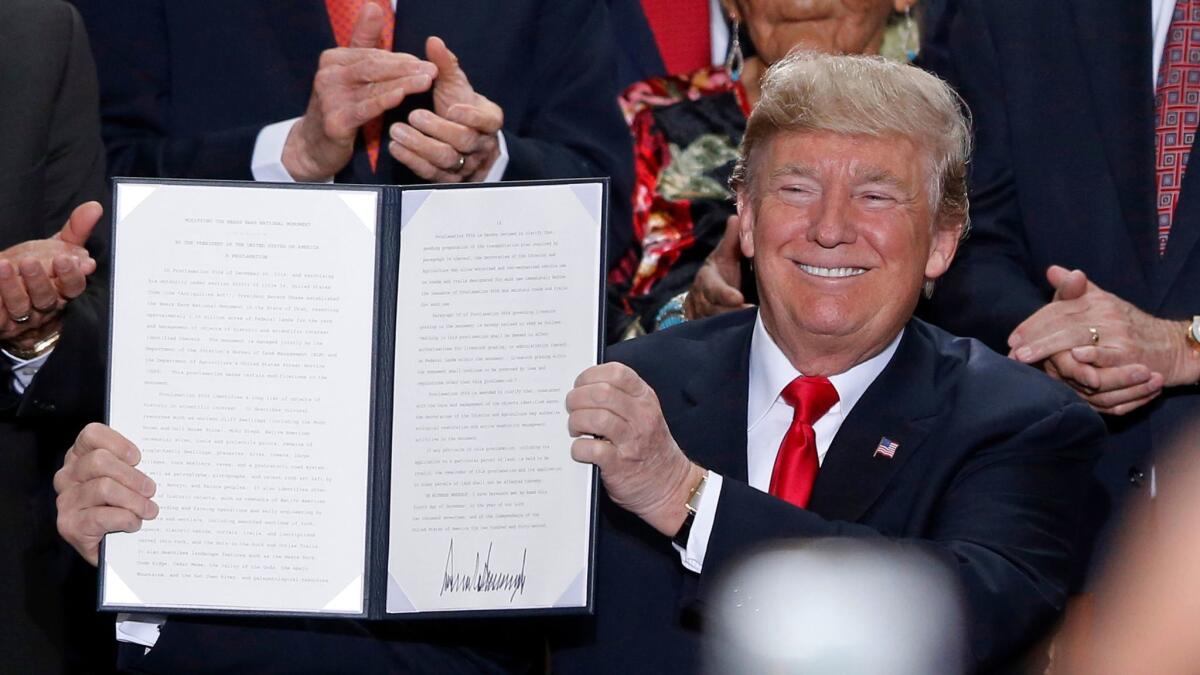Editorial: Trump eviscerates two national monuments in the name of political back-scratching

More than two decades ago, President Clinton tried to end a long-running political battle over the future of 1.9 million acres of federal land in southern Utah by creating the Grand Staircase-Escalante National Monument. Last year, President Obama took a similar step and created the nearly 1.4-million-acre Bears Ears National Monument in southeastern Utah. Both designations protected vast swaths of public land from mining and other industrial uses, and offered extra safeguards for natural habitats and pre-Columbian Native American sites.
But on Monday, President Trump eviscerated both federal designations, proving once again that, to this president, the federal governmentâs promises to its own people mean nothing. The presidentâs decision â which amounts to the largest elimination of protected area in American history â senselessly imperils stunningly beautiful natural areas and geological masterworks, as well as tens of thousands of Native American sacred sites and key wildlife habitats.
Trump didnât bother to travel all the way to the red rock canyons of Utah to make his announcement, proudly declaring in the state Capitol building in Salt Lake City that he would cut by half the protected area currently within the Grand Staircase-Escalante monument, and remove more than 1 million acres from Bears Ears, leaving only 230,000 acres in two separate new monuments, Shash Jaa (Navajo for Bears Ears) and Indian Creek. Trump said he wanted to undo previous administrationsâ âoverreachâ in establishing monuments much larger than necessary to protect specific sites. Yet he offered no evidence to support his claims of overreach.
This is nothing more than a giveaway to mining and other extractive industries, and a favor to conservative anti-public lands Republicans in Utah.
In fact, this is nothing more than a giveaway to mining and other extractive industries, and a favor to conservative anti-public lands Republicans in Utah, lead by Sen. Orrin G. Hatch and Rep. Rob Bishop, who believe that land owned by the federal government should be turned over to states for management and development decisions. As weâve argued before, states should not take over public lands held in trust by the government for all of us.
The Utah monuments were created under the authority of the 1906 Antiquities Act, a law intended to give a president the flexibility to act quickly to preserve federal lands that hold âhistoric landmarks, historic and prehistoric structures, and other objects of historic or scientific interest.â Both Republican and Democratic presidents have used the law to preserve land that, in many cases, Congress later decided to designate national parks, which carry even stronger protections. In fact, more than half of the nationâs 59 national parks began as, or include within them, national monuments, including the Grand Canyon, Bryce and Zion â three gems of the Southwest. In undoing the Grand Staircase designation, Trump imperils a regional outdoor recreation economy that has led to an increase in both jobs and per-capita income, for the chimera of riches from mines that ultimately might never get dug (the territory is vast and remote, making exploitation expensive).
And Trump isnât done yet. The undoing of the Utah designations is part of a 27-monument review conducted by the Department of the Interior at Trumpâs direction; more trims are likely at some of those other sites. Secretary Ryan Zinke also reportedly has recommended changes in the management of some of the monuments, such as expanding grazing rights and road construction, which critics say will undercut the very things the designations were supposed to protect. Trump also has asked for recommendations on possible legislative changes to the Antiquities Act that would make it harder for future presidents to use it. What exactly Zinke has recommended remains under wraps.
Fortunately, Trumpâs assault on federal lands has energized environmental activists, and several organizations have already promised to sue. Among the issues is whether Trump can legally shrink the monuments by declaration. The Antiquities Act gives the president the power to create monuments and it gives Congress the power to make changes, but it is silent on whether a president can undo a previous presidentâs declaration. Several presidents have made mostly minor changes to previous declarations, but none of those have been challenged in court, so this is uncharted ground. Environmental groups also argue that changing a monumentâs âmanagement planâ requires the government to show that the existing plans are somehow faulty.
If Trump could articulate a sensible reason for his heavy-handed actions, the nation would owe him a listen. But he hasnât, and such a transparent effort to reward political allies and mining interests should be fought vigorously.
Follow the Opinion section on Twitter @latimesopinion or Facebook
More to Read
A cure for the common opinion
Get thought-provoking perspectives with our weekly newsletter.
You may occasionally receive promotional content from the Los Angeles Times.










